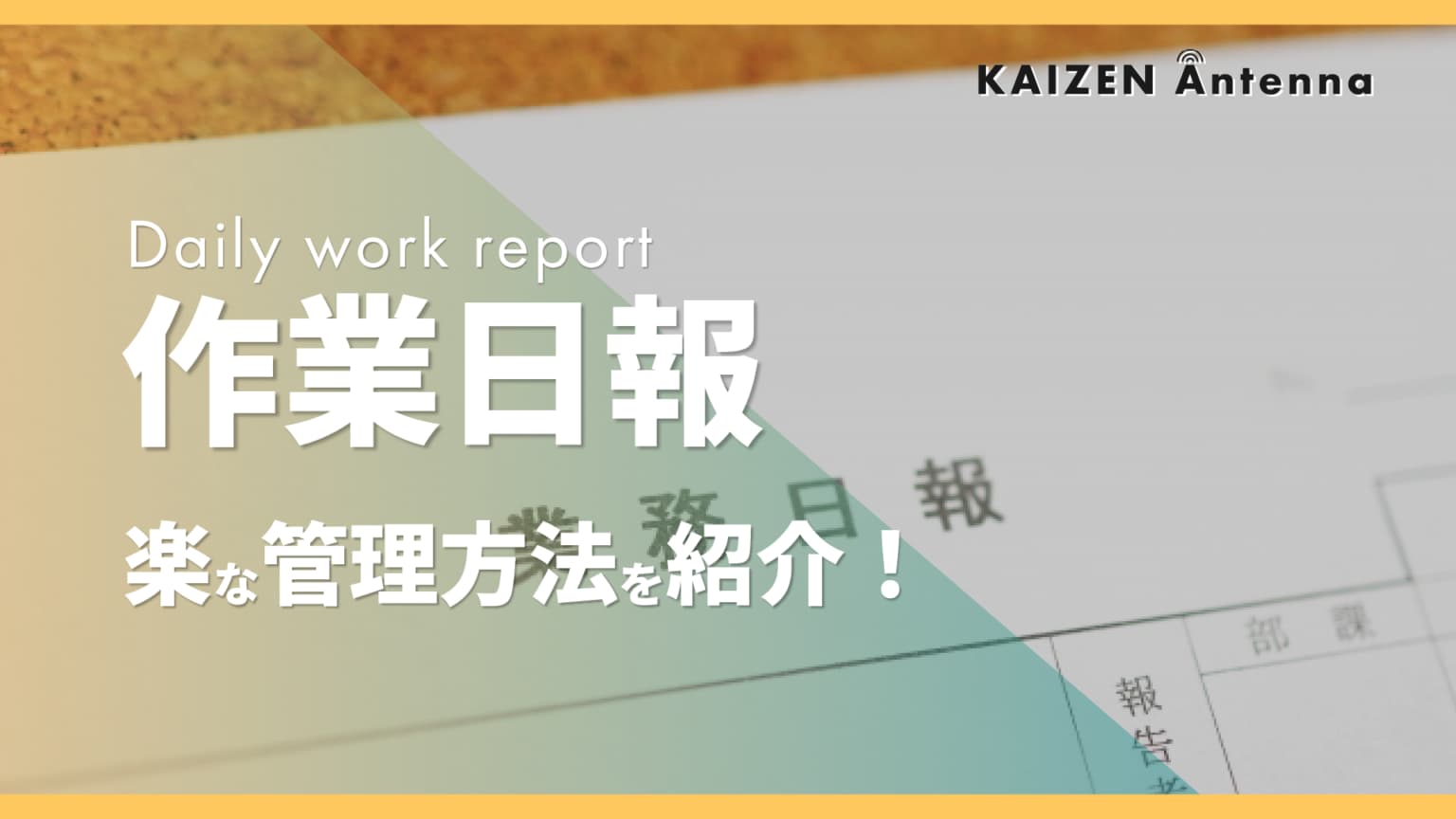Manufacturing and construction sites can be said to be sources of value creation. However, these sites face a variety of problems and many challenges. One particularly significant challenge is the current…
What is standard work? The three necessary elements, the three votes, work procedures, and differences from work standards
table of contents
In manufacturing sites, improving work efficiency is a constant challenge.
However, there are many cases where you may be unsure of what measures to take to achieve efficiency.
In this article, we will explain the key points of "standard work," which is the foundation for achieving high productivity and quality control.
We will also explain in detail the three elements and three votes necessary for formulating standard work, so please use this as a reference if you are a company that is facing issues such as declining work efficiency and longer lead times.
Purpose of Standard Work
To optimize work procedures and improve business efficiency, you must first define standard work.
This is because if standard work is not decided, it is impossible to determine what the current problems are and what needs to be improved. Here we will introduce the overview and purpose of standard work.
What is standard work?
Standard work is a method of working to manufacture products faster, safely, and without waste.
The most efficient combination of materials and equipment is considered and implemented, focusing on the way people move. By defining standard work, it becomes easier for the person in charge to understand the work procedures and tools to be used, and the benefit is that they can proceed with the work without hesitation.
When formulating standard work, it is common to use a method for on-site improvement called the "three elements" and "three votes."
The three elements are "time takt," "work sequence," and "standard on-hand." The three forms are three types of forms: "process capacity chart," "standard work combination chart," and "standard work chart." The meaning, role, and creation procedure of each will be explained later.
Purpose of standard work
The main purpose of defining standard work is to clarify manufacturing methods and rules and improve efficiency.
By establishing standard work, it becomes easier to standardize the way workers move, which is expected to improve productivity. It also reduces waste caused by differences in work methods and management methods.
In addition, standard work is also important for creating criteria for judging whether work is being done properly. If the current work does not meet the standard, it can be assumed that there is a problem somewhere and efforts can be made to improve it.
Three elements of standard work
Next, we will explain the meaning and role of the three elements of standard work. By determining the three elements of standard work, it is possible to reduce waste by considering the efficient combination of human movements, materials, and equipment.
Takt Time
Takt time refers to the time required to produce one product or part. In the manufacturing industry, the basic principle is to determine the required number of products to be produced within a certain period of time in order to prevent stockouts and excess inventory.
To achieve this, it is important to know how much time it takes to manufacture each product or part, and this time is called takt time.
Takt time can be calculated using the formula "operating time / required production quantity." Note that slack is not taken into account when calculating takt time.
The margin rate is the ratio of margin time to net time. Takt time can be said to be the target time for producing one product, so there is no margin rate.
By adjusting the work time for one cycle to the takt time, it is possible to improve operations and increase the availability rate.
work order
The work sequence is the order in which workers perform their work efficiently. By reviewing the order of each work, such as transportation, processing, and assembly, from an efficiency perspective, it is possible to shorten product manufacturing time and reduce work waste.
It is important that the work sequence is designed so that anyone can perform the work efficiently. Therefore, when optimizing the work sequence, it is desirable to take into account the opinions of workers on-site.
Standard handheld
Standard on-hand represents the minimum amount of work-in-process required to perform a repetitive operation while adhering to cycle time and operation sequence.
Cycle time refers to the actual time it takes to complete one process, and work in progress refers to unfinished products that are being worked on within a process.
Cycle time includes the time it takes to set materials into the machine and to inspect it. Cycle time can be calculated by dividing the operating time by the actual number of units produced.
If there is too much standard inventory, there is a risk of overproduction, which will result in unnecessary occupation of work space and work loss in subsequent processes.
On the other hand, if the standard on-hand quantity is too small, waiting for work will occur and productivity will decrease. Therefore, it is important to set an appropriate number for the standard on-hand quantity, taking into consideration the workflow and layout.
3 votes for standard work
Here, we will explain the characteristics of the three forms used to create standard work, the purpose of creating them, and how to create them.
Creating three forms will make it easier to carry out on-site improvements, management, and guidance smoothly.
Capability table by process
Purpose of creation
A process capacity chart is a document created to understand the production capacity of each process.
By entering the manual labor time and automatic feed time required for each process, you can clarify the processing capacity of the entire line and the bottleneck processes.
A bottleneck is a term that refers to the point in the overall work process that has the most negative impact.
Process capacity tables are also useful when determining improvement targets and priorities. By using a process capacity table to compare the production capacity of each process, you can quickly determine which processes have problems and which processes should be improved as a priority.
In addition, the process capacity chart can also be used as reference when creating the standard work combination chart described below.
General method for creating a process capacity chart
- When creating a process capability table, first enter the basic product information such as product number, model number, product name, quantity, etc.
This will clarify which product you are checking production capacity for. - The order of each process, process name, and machine number are listed. By clarifying the information for each process, it becomes easier to visually understand the manufacturing flow.
- Enter the manual work time and automatic transfer time in the basic time column.
Manual labor time is the time that workers actually use their hands to perform a task, and does not include the walking time required to move between processes.
Automatic feed time refers to the time from when the equipment is started until it stops after completing the operation. - In the cutting tool column, record the number of cutting tools replaced and the replacement time.
Many cutting tools are used in the manufacturing process, and replacing them takes a certain amount of time. Therefore, in order to compare the production capacity of each process, it is necessary to confirm in advance the number of cutting tools used in each process and the replacement time. - Using the information above, calculate the processing capacity of each process and record the process with the lowest value as the bottleneck process.
Processing capacity can be calculated by "operating time ÷ (completion time per product (manual time + automatic feed time) + tool replacement time per product (number of tool replacements ÷ replacement time))".
When improving business processes, priority is given to starting with the bottleneck process.
Also, if you include a line diagram of manual work and automatic feed in the remarks column, it will help you visualize the bottleneck process. It will be easier to understand if you enter different types of lines, such as a solid line for manual work time and a dotted line for automatic feed time.
Standard work combination sheet
Purpose of creation
The standard work combination sheet is a document for discovering and improving waste in worker actions.
Specifically, we identify the scope of work each worker is responsible for, and then compare the cycle time and takt time. If there is a discrepancy between the two, we consider ways to improve the process to close the gap.
The basic rule is to create one standard work combination sheet for each worker. By reviewing the appropriate combination of workers and equipment and the work order, the aim is to bring the cycle time as close as possible to the takt time.
The standard work combination chart also serves as the basis for creating the standard work chart, which will be described later.
Example of how to create a standard work combination chart
- When creating a standard work combination chart, first draw a red line representing the takt time on the time axis.
Since these lines are the target for workers, it is important to make them visually easy to understand. - Enter the details of each task in the task details column and add manual tasks that correspond to actual production.
Specifically, possible items include "collecting materials" and "arranging the finished products."
Then, after you have written down the time it takes for each task, draw a line on the timeline to check the cycle time.
It is easier to understand if you use different lines, such as solid lines for manual work time and dotted lines for walking time. - Compare cycle time and takt time, and if there is a difference, consider areas for improvement.
Standard work sheet
Standardized work charts are essential documents for improving work efficiency and quality at manufacturing sites.
By clarifying procedures so that workers can proceed accurately without getting lost and reducing waste, we can expect to improve productivity.
The difference between standard work and work standards
Standard work and work standards are both terms related to the standardization of work, but there are differences in their purpose and content.
Standard work aims to optimize the overall work on a production line. It is primarily used as a tool for improving production sites by clarifying worker movements, work order, and on-hand tasks based on takt time, reducing waste and improving productivity.
A work standard (work standard manual) is a document that details the procedures and methods for each work task, quality check points, safety precautions, etc.
It covers all the information necessary to ensure the accuracy and safety of work, including training for new employees, quality control, and how to respond when problems occur.
Purpose of creation
The Standardized Work Chart is a form that visualizes the entire work process and allows you to consider areas for improvement.
By compiling specific worker movements, machine placement, and work procedures into a single document based on the process capacity chart and standard work combination chart, it becomes easier to grasp the overall picture of the work.
In addition, by showing the three elements of standard work (time takt, work sequence, and standard on-hand work), you can check points such as waste such as walking and on-hand work, as well as safety and quality checks.
Example of how to create a Standardized Work Chart
- When creating a standardized work chart, first enter the first and last tasks listed on the standardized work combination chart in the work content column.
This clarifies the scope of work for each worker. - Create an image diagram that corresponds to the layout of the work site and fill in the numbers according to the work procedures listed on the standard work combination chart. Connect each task in numerical order with a solid line, and use a dashed line to indicate the return from the last task to the first task. This will help you visualize the overall flow of work.
- Once you've completed the process, mark the locations of equipment and processes with standard wait times, quality checks, and safety precautions as necessary. If there are any areas where the flow of movement is long, use this to improve your work, such as by changing the layout of the equipment.
The need for work standards
Work standards are important documents for ensuring the quality of work at manufacturing sites and improving productivity.
By clarifying specific work methods and procedures, it is possible to prevent variations between workers, achieve stable quality, and also use it as a training tool for new employees, enabling efficient human resource development.
By properly implementing work standards, a consistent level of quality can be ensured regardless of who is performing the work, reducing the occurrence of defective products and improving productivity by reducing waste and improving work efficiency.
In addition, dangerous work and points to be careful of will be clarified, ensuring safety, preventing dependency on individuals and maintaining the continuity of work. Furthermore, by visualizing the current work, it will serve as a benchmark for identifying areas for further improvement.
Expected effects of standard work
What kind of effect does creating standard work have on manufacturing sites? Here we will explain from four perspectives.
Improved quality control
Establishing standard work helps maintain consistent quality. By clarifying work procedures and rules, work is standardized, reducing variations due to the skills and experience of each worker. This makes it easier to prevent work errors and defective products, and can also reduce waste due to rework and disposal.
Increased productivity
Building standard work also contributes to improving productivity. This is because it allows you to establish efficient work methods by reviewing the manufacturing process, eliminating unnecessary movements and procedures, and improving bottleneck processes. In addition, setting time takt time and standard on-hand time also makes it easier to optimize production plans and process balance.
Improved safety
By standardizing work processes through the introduction of standard work, you can reduce the number of cases where workers perform work in the wrong way. As a result, you can prevent dangerous movements that could lead to injuries or accidents, and improve safety. You can see even greater benefits by working on this in conjunction with 5S (sort, set in order, shine, standardize, and sustain) activities.
Shortening the training period
Standard work also has the effect of shortening the training time for new employees and transferred employees. By formulating standard work, the way work is carried out can be clarified, and even new employees and transferred employees can smoothly understand the work content. If the training period can be shortened and personnel can be made effective early, it will also lead to improved productivity.
Procedures for working on standard work
Finally, we will explain the procedures and tips for formulating standard work in six steps. If you are facing issues with your company's manufacturing line, try starting to make improvements by following the steps below.
Step 1: Clarify the purpose and prerequisites
First, set specific prerequisites and goals for introducing standard work. In the prerequisites, determine the target operations and scope, as well as the users and managers. In terms of objectives, clarify what you want to achieve by introducing standard work, such as improving production efficiency or quality. Then, set evaluation indexes and target values for standard work so that you can measure the degree of achievement.
Step 2: Organize your work
Next, organize the actual work content, calculate the three elements of standard work, and create three forms. This is the step where you observe the current work situation and check for any wasteful work, variations, or procedural deficiencies.
Step 3: Repeat work training
Next, standard work is set, and after explaining the contents to the workers, they undergo repeated training. The key is to continue providing feedback and guidance until the workers understand the new work procedures and methods and are able to perform the work as specified.
Step 4: Find the problem
The next step is to implement the standard work on-site and check for any gaps with reality. If there are any problems or waste that were not discovered during the work training, analyze them in detail using the 5W1H (who, when, where, what, why, and how) to identify the root cause.
Step 5: Make an improvement suggestion
Once you have identified the problem and its root cause, the next step is to consider improvement measures. Implement the improvement measures using the PDCA cycle, and measure and verify their effectiveness. PDCA stands for "Plan, Do, Check, Act."
Step 6: Create a new standard work
Finally, if the above improvement measures are effective, they should be established as new standard work in the workplace. It is a good idea to create and implement three new standard work forms or standard operating procedures (SOPs). If the goal is not achieved, you can further optimize the standard work by repeating the steps from step 4.
Let's create standard work and achieve on-site improvements!
This time, we explained the purpose of defining standard work, an overview of the three elements and three votes, the effects of the initiative, and the procedures.
Standard work is an essential concept for achieving efficiency and quality improvements on the manufacturing floor.
If productivity is declining or lead times are being extended due to work being personalized or procedures are inadequate, develop standard work and promote on-site improvements.
To manage documents used at manufacturing sites, we recommend using the on-site report system "i-Reporter."
[Improving work accuracy and productivity in the retail industry]
Make store operations smoother with the on-site document digitization solution "i-Reporter"!
- You can check inventory and sales floor information for each store in real time.
・Convert paper documents to electronic documents → Reduce reporting lags and transcription errors
・Comprehensive digitalization of production management, inspection, patrol, and inventory management
i-Reporter is a field report system with a wide range of functions


This is the editorial department of the Field Document Research Institute!
This blog is operated by CIMTOPS Corporation., which develops and sells the field document electronic solution "i-Reporter."
We will be delivering industry information on a regular basis to help those of you working hard to promote digital transformation in the workplace, so please take a look!
















